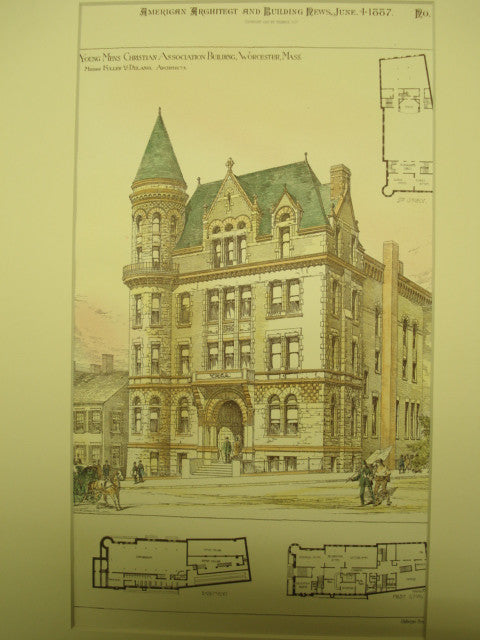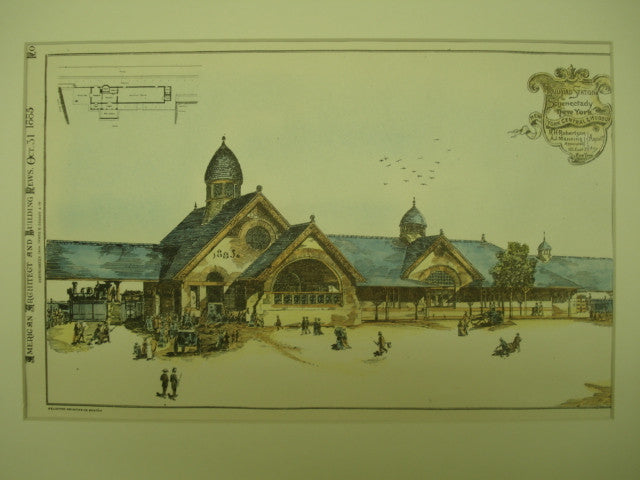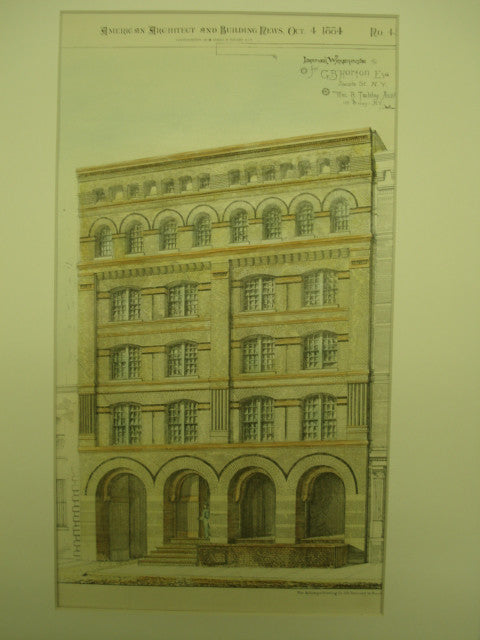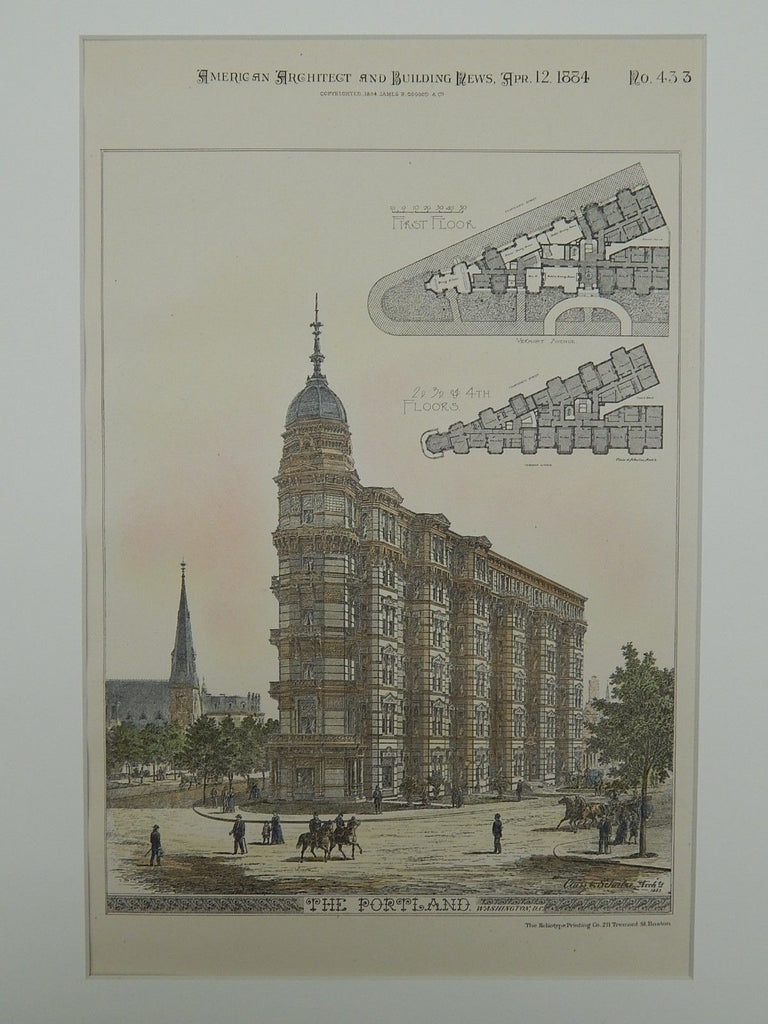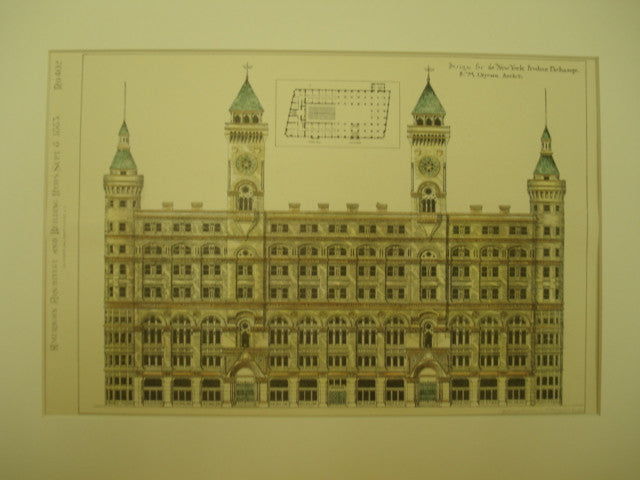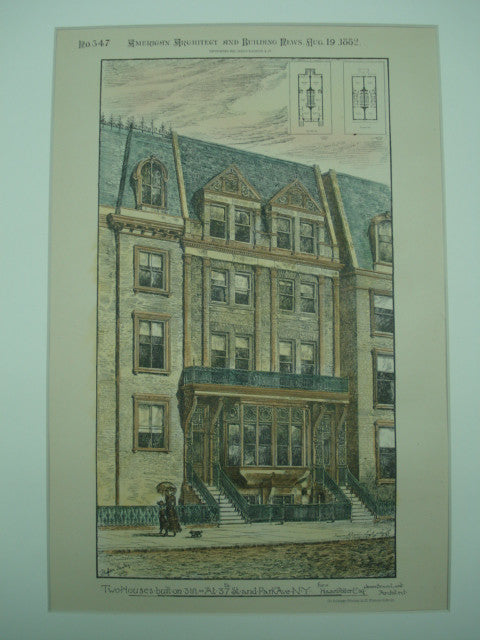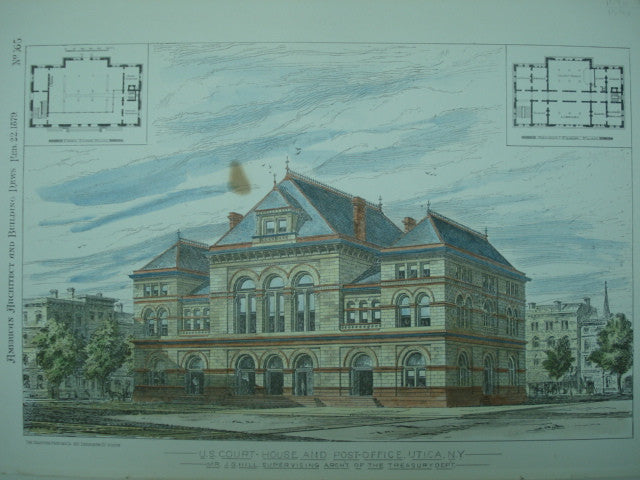News
Fine Dining and Athletics in 1887 August 28 2015
This is the twelfth installment in our series of posts comparing significant events from a year in United States history with a few of our unique architectural plans from the same period. 1887, the topic of this installment, subsequently marks the twelfth year of the American Architect and Building News' existence.
Click on the pictures to find the plans below in our store!
In New York City during the mid-nineteenth century, the Delmonico name was synonymous with fine dining throughout the nation. The family owned a number of restaurants throughout the city and was best known for pioneering the forever imitable Delmonico steak. Below is an 1887 plan for a new Delmonico's Restaurant at 341 Broadway in New York City, designed by prominent architect James Brown Lord. Though it is unclear whether this location came into existence, seeing Lord attached to the Delmonico name provides an interesting look at the influence the Delmonico family and their food had over the city.
The Young Men's Christian Association was founded by George Williams in mid-nineteenth century London. Williams was concerned about the lack of healthy activities for young men living in cities in the period soon after the industrial revolution and sought to provide new access for them. By the 1880s, the YMCA had spread throughout the Western world, providing opportunities for sportsmanship and athletic contests, as well as promoting evangelical Christian services. This 1887 plan for the Young Mens Christian Association Building in Worcester, Massachusetts designed by Fuller & Delano exemplifies the popularity and reach of the association in such a short amount of time. And this was just the beginning of the YMCA's storied history.
The Nation Develops in 1885 August 24 2015
This is the tenth installment in our series of posts comparing significant events from a year in United States history with a few of our unique architectural plans from the same period. 1885, the topic of this installment, subsequently marks the tenth year of the American Architect and Building News' existence.
Click on the pictures to find the plans below in our store!
On February 16 of 1885, the first edition of the Dow Jones Industrial Average was published by Charles Dow, a major step in the development of the United States' economy. The average originally represented the dollar average of 14 of the most important United States stocks, while today it represents the average of 30. The original average consisted of 12 railroads, including the New York Central railroad. A beautiful station for the New York Central, as well as the Hudson River Railroad in Schenectady, New York is presented below, designed by R. H. Robertson & A. J. Manning.
In Chicago, Illinois, the tallest building in the world was completed in 1885. The Home Insurance Building was ten stories tall and the world's first skyscraper. It was the king for four years, until being passed by the Auditorium Building in 1889, also built in Chicago. This plan for the Adams Express Building for A.J. Cooper & Jas D. Carson from 1885 in Chicago only has eight stories, but was sure to tower over the rest of the city when its Geo. H. Eabrooke design was completed.
Workers Win in 1884 August 21 2015
This is the ninth installment in our series of posts comparing significant events from a year in United States history with a few of our unique architectural plans from the same period. 1884, the topic of this installment, subsequently marks the ninth year of the American Architect and Building News' existence.
Click on the pictures to find the plans below in our store!
On May 1 of 1884, the first recognized May Day, the Federation of Organized Trades and Labor Unions in the United States declared the eight-hour workday the mandatory maximum for workers in the United States (without being awarded overtime pay). Though the United States government didn't enact any laws around this issue until about 30 years later, this was an important step in securing workers' rights in the country. The workers at this Leather Workhouse for G. B. Horton in New York, New York would have been especially grateful hearing about this decision. The building was designed by Wm. B. Tubby.
After years of planning and construction, the Washington Monument in Washington, DC was finally completed in December of 1884. Designed by Robert Mills, it is not only the world's tallest obelisk, but the world's tallest stone structure of any shape. Located a few blocks north of the monument, this design for the Portland Building by Cluss & Schulze came out in April of the same year. Be sure to also take a look at our various plans for the Washington Monument here.
Times Change in 1883 August 19 2015
This is the eighth installment in our series of posts comparing significant events from a year in United States history with a few of our unique architectural plans from the same period. 1883, the topic of this installment, subsequently marks the eighth year of the American Architect and Building News' existence.
Click on the pictures to find the plans below in our store!
On May 24 of 1883, the Brooklyn Bridge in New York City opened to the public after 13 years of construction. The bridge connected Manhattan and Brooklyn, stretching over a mile across the East River. Just six days after it's opening, a stampede on the bridge occurred over rumors of the bridge's collapse, causing 12 people to be crushed in the resulting chaos. This design for the New York Produce Exchange by R. M. Upjohn would have been located nearby in Manhattan, and any Brooklyn or Long Island producers would now have an easy way to reach it and sell their wares. Upjohn is well-known for his Gothic Revivalist style, spurring the movements popularity in the country.
November of 1883 brought along the founding of universal time zones throughout the United States. The idea was put forth by the U.S. and Canadian railroad companies as a better means for planning arrivals and departures for their trains. Though the boundaries for the zones looked much different than they do today, the establishment of these ended much confusion throughout the nation with regard to scheduling. This combination United States Court House and Post Office designed by Jas. G. Hill in Quincy, Illinois would have benefited much from the zones' creation, as the Postal Service would have had a much easier time keeping their schedule.
Electricity Begins and Poetry Ends in 1882 August 17 2015
This is the seventh installment in our series of posts comparing significant events from a year in United States history with a few of our unique architectural plans from the same period. 1882, the topic of this installment, subsequently marks the seventh year of the American Architect and Building News' existence.
Click on the pictures to find the plans below in our store!
Thomas Edison continued to shape the nation's history in 1882. To add to his list of ever-growing achievements, he established the world's first commercial electric power plant, giving electricity to an entire square mile of lower Manhattan. These two houses, at 37th Street and Park Avenue for Howard Potter, might have not been in that original lighted area, but were sure to soon feel the full effects of Edison's genius. They were designed by the master of the Beaux-Arts style, James Brown Lord.
On March 24, 1882, Henry Wadsworth Longfellow succumbed to peritonitis in his Cambridge, Massachusetts home in the company of his close family. The celebrated poet and Harvard professor was best known for his works The Song of Hiawatha and Evangeline, though he was also the first American to produce a translation of The Divine Comedy by Dante Alighieri. The First Baptist Church of Cambridge, Massachusetts (whose interior is shown below) would have been quite near Longfellow's home, though Longfellow did not attend himself. It was designed by Hartwell & Richardson.
US Goes on the Gold Standard in 1879 August 10 2015
This is the fourth installment in our series of posts comparing significant events from a year in United States history with a few of our unique architectural plans from the same period. 1879, the topic of this installment, marks the fourth year of the American Architect and Building News' existence.
Click on the pictures to find the plans below in our store!
1879 brought into the effect the Specie Resumption Act within the United States. For the first time since before the Civil War, the value of paper currency within the nation became equal to that of gold. This led to more faith in the American economy by consumers, and a willingness to spend their money in stores, such as these on Devonshire and Summer Streets in Boston, Massachusetts. These were designed by notable Boston architects Cummings & Sears and can be found in wonderful detail on the plan below.
Frank Winfield Woolworth founded the first of what would become numerous of his famous Woolworth stores in 1879. Located in Utica, New York, these revolutionary new stores sold items at the firm price of five- and ten-cents apiece; a new idea at the time, as previous vendors usually would sell their items at prices determined by haggling. These stores created the shopping experience we're used to today, so much so that their "Five-and-Dimes" name still persists in the common American vernacular. The plan below depicts the United States Court House and Post Office in Utica, New York, designed by J. G. Hill in 1879. This building would have been just down the street from the first of Mr. Woolworth's soon-to-be famous stores.
U.S. Architecture Ramps Up in 1877 August 05 2015
In the United States, 1877 marked the end of the Reconstruction Era, which brought the South back into the fold in the decade following the Civil War. However, the end of this era didn't hinder the advance of architectural progress in the United States. In it's second year, the American Architect and Building News continued to provide architects with all of the significant happenings within their industry.
Click on the pictures to find the plans below in our store!
In June, cadet Henry Ossian Flipper became the first African American graduate from the United States Military Academy in West Point, New York. October brought more to West Point, when General George Armstrong Custer was laid to rest at the Academy following his death at Little Big Horn the previous year. Remembrance toward the nation's fighting men became more popular, as evidenced by this Soldiers' Memorial Chapel in Akron, Ohio, designed by Frank O. Weary.
July of 1877 brought riots by Baltimore and Ohio Railroad railroad workers in Baltimore, Maryland. This would lead to a strike and more rioting by their fellow railroad workers in Pittsburgh, Pennsylvania. In St. Louis, another worker's rebellion established a Communist government for a short time before the newly appointed President Hayes decided to call in the nation's armed forces to quell the uprising. In more tranquil areas of the industry, this railroad station was built in Providence, Rhode Island. It's design was handled by premier Boston architects Peabody & Stearns.
Architecture Comes of Age in the US in 1876 August 04 2015
The American Architect and Building News, which began in 1876, signaled that architecture was becoming a full fledged profession. When looking at buildings built in specific years, it's interesting to find out what was happening at the time. In this series of postings, we will note some of the interesting events that took place while some of the buildings that appear on our website were being built. In 1876, for example, the first electric dental drill was patented, the first recorded hockey game was played in Montreal and the first shutout in baseball was achieved by Chicago (1) over St. Louis (0).
Click on the pictures to find the plans below in our store!
In Philadelphia, the Centennial Exposition celebrated the 100th anniversary of the signing of the Declaration of Independence. It was the first event of its kind in the United States, and was visited by over 10 million attendees. The plan below depicts the headquarters building built for the state of New Jersey during the event, one of many built for each state. This one was designed by Carl Pfeiffer.
Elsewhere, the leader of New York's corrupt Tammany Hall political organization, Boss Tweed, was extradited to New York City for prosecution after being captured in Spain. Here's a plan by Cornwell & Maynicke for the new city hall built in Brooklyn, just a short walk over the East River from Tweed's usual stomping grounds.


